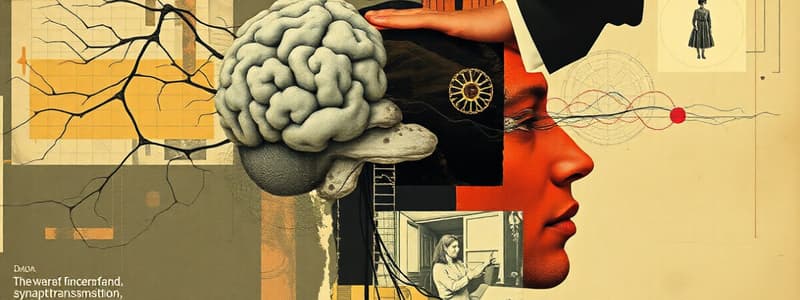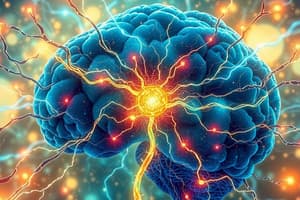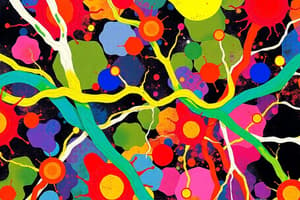Podcast
Questions and Answers
What is the role of the corticospinal tract?
What is the role of the corticospinal tract?
- Sensory processing
- Pain perception
- Motor control (correct)
- Balance regulation
Which cranial nerve is responsible for the sense of smell?
Which cranial nerve is responsible for the sense of smell?
- Optic Nerve
- Olfactory Nerve (correct)
- Trigeminal Nerve
- Oculomotor Nerve
Which layer of the neocortex contains large pyramidal cells?
Which layer of the neocortex contains large pyramidal cells?
- Layer II
- Layer VI
- Layer IV
- Layer V (correct)
What is the primary function of the vestibulospinal tract?
What is the primary function of the vestibulospinal tract?
At which spinal cord levels would UMN signs be observed in all four limbs due to damage?
At which spinal cord levels would UMN signs be observed in all four limbs due to damage?
Which structure is NOT part of the basal ganglia?
Which structure is NOT part of the basal ganglia?
Which neuron type is associated with Cranial Nerve V, the Trigeminal Nerve?
Which neuron type is associated with Cranial Nerve V, the Trigeminal Nerve?
Which deep nucleus is associated with the lateral hemisphere of the cerebellum?
Which deep nucleus is associated with the lateral hemisphere of the cerebellum?
What is the role of the perforant path in the trisynaptic circuit?
What is the role of the perforant path in the trisynaptic circuit?
Which of the following correctly outlines the steps in synaptic transmission?
Which of the following correctly outlines the steps in synaptic transmission?
Which component artery is part of the Circle of Willis?
Which component artery is part of the Circle of Willis?
What is the primary function of the blood-brain barrier?
What is the primary function of the blood-brain barrier?
Where do the dorsal root sensory fibers synapse in the spinal cord?
Where do the dorsal root sensory fibers synapse in the spinal cord?
Which statement is true about the spinal nerves?
Which statement is true about the spinal nerves?
What is the primary output structure of the hippocampus?
What is the primary output structure of the hippocampus?
The intermediate horn of the spinal cord contains which type of cell bodies?
The intermediate horn of the spinal cord contains which type of cell bodies?
How do the communicating arteries of the Circle of Willis function?
How do the communicating arteries of the Circle of Willis function?
Which type of information do spinal tracts carry?
Which type of information do spinal tracts carry?
Flashcards
Perforant Path
Perforant Path
A pathway in the hippocampus that connects the entorhinal cortex (EC) to the dentate gyrus (DG).
Mossy Fibers
Mossy Fibers
Axons from granule cells in the dentate gyrus (DG) that project to CA3 pyramidal cells in the hippocampus.
Schaffer Collaterals
Schaffer Collaterals
Axons from CA3 pyramidal cells that project to CA1 pyramidal cells in the hippocampus.
Emotional Encoding
Emotional Encoding
Signup and view all the flashcards
Neurotransmitter Synthesis
Neurotransmitter Synthesis
Signup and view all the flashcards
Neurotransmitter Packaging
Neurotransmitter Packaging
Signup and view all the flashcards
Neurotransmitter Release
Neurotransmitter Release
Signup and view all the flashcards
Neurotransmitter Binding
Neurotransmitter Binding
Signup and view all the flashcards
Neurotransmitter Termination
Neurotransmitter Termination
Signup and view all the flashcards
Neural Crest Cells
Neural Crest Cells
Signup and view all the flashcards
Tract
Tract
Signup and view all the flashcards
2-neuron tract
2-neuron tract
Signup and view all the flashcards
3-neuron tract
3-neuron tract
Signup and view all the flashcards
Decussation
Decussation
Signup and view all the flashcards
Ascending Spinal Tract
Ascending Spinal Tract
Signup and view all the flashcards
Descending Spinal Tract
Descending Spinal Tract
Signup and view all the flashcards
Neocortex
Neocortex
Signup and view all the flashcards
Basal Ganglia
Basal Ganglia
Signup and view all the flashcards
Study Notes
Final Exam Information
- Exam date: December 13th
- Exam time: 2:30 PM - 4:30 PM
- Exam location: ROZ 103
- Exam format:
- 60 multiple choice questions (worth 60 marks)
- 5 short answer/labeling questions (worth 40 marks)
- Scrap paper will be provided
From Last Class - Trisynaptic Circuit
- Perforant path (2 connections)
- EC (Entorhinal Cortex) to DG (Dentate Gyrus)
- Mossy fibers (3 connections)
- DG (Dentate Gyrus) to CA3
- Schaffer collaterals (3-4 connections)
- CA3 to CA1
- Hippocampal Output (three parts):
- Fimbria/Fornix
- Entorhinal Cortex
From Last Class - Linking Perception & Emotion
- Linking perception of objects/situations with emotional responses
- Primarily emotional responses associated with fear
- Emotional aspects of learning
Steps in Synaptic Transmission
- Production of neurotransmitters
- Packing of neurotransmitters
- Release of neurotransmitters
- Binding to receptors
- Termination of neurotransmitter action
Development - Neural Crest
- Neural crest cells form most of the neurons and glial cells of the PNS, as well as other tissues
Ventricular System
- The developing ventricular system, including ventricles (lateral, third, and fourth) and the aqueduct are part of this system.
- The choroid plexuses are shown in red. This system regulates cerebrospinal fluid (CSF)
Circle of Willis
- Comprised of 5 component arteries: internal carotid, anterior cerebral, anterior communicating, posterior cerebral, and posterior communicating artery.
- If a major vessel is occluded, the communicating arteries can help perfusion to the distal tissues.
Blood-Brain Barrier
- Choroid epithelium regulates the composition of CSF and facilitates the flow of components to and from plasma.
- Intracerebral capillaries separate the extracellular space of the CNS from the rest of the body.
- Arachnoid barriers prevent diffusion into the subarachnoid space from outside the CNS.
Spinal Cord Organization
- Central, H-shaped grey matter is surrounded by white matter.
- Grey matter (Dorsal, intermediate, ventral horns) contain entry/exit points for sensory and motor information.
- White matter contains various spinal tracts.
Spinal Nerves
- Spinal cord is segmented, and each segment produces a bilateral pair of spinal nerves.
- Ventral and dorsal roots coalesce to form spinal segments.
- Spinal nerves are formed from these segments.
Spinal Tracts
- These are physiologically distinct tracts that carry specific sensory or motor information.
- Most tracts consist of 2 or 3 neurons.
- Major ascending tracts: DCML and AL.
- Major descending tracts: corticospinal and vestibulospinal.
- Tracts have consistent locations in the spinal cord and neurons usually cross over (decussate) at some point in their pathway.
Ascending Spinal Tracts
- Sensory information from the spinal cord is relayed to the thalamus, which is a gateway to the somatosensory cortex.
- Different tracts deal with different types of sensory information.
- Large-diameter afferents carry information from the arms and legs.
- Small-diameter afferents carry other sensory information.
Descending Spinal Tracts (Corticospinal)
- Descending tracts carry motor information.
- Other tracts include vestibulospinal/rubrospinal.
- Some key information, such as origin and role, is not yet specified in the notes.
Spinal Cord Damage
- Damage to different parts of the spinal cord leads to different symptoms, including sensory and motor impairments.
- Posterior columns are associated with touch and position sense.
- The spinothalamic tract relates to pain and temperature sensation.
- Lateral corticospinal tracts affect strength, tone, and reflexes.
- The anterior horn (lower motor neurons) impacts strength, tone, and reflexes, often causing atrophy.
The Cranial Nerves
- 12 pairs of cranial nerves, some are sensory, some motor, and some are both. A mnemonic is provided to remember them.
Cerebellum Connectivity
- Anatomical components include flocculonodular lobe, vestibular nuclei, Vermis, Fastigial nucleus, medial, interposed, and lateral hemispheres, and dentate nucleus.
Neocortex
- The neocortex is divided into layers with varying cell types.
- Layer I is cell-poor, Layer II contains granular cells, Layer III has small pyramidal cells, Layer IV contains granular cells, Layer V has large pyramidal cells, and Layer VI includes fusi/multiform pyramidal cells.
Basal Ganglia
- Important structures include the striatum (caudate and putamen), Globus Pallidus external and internal segments (GPe and GPi), Subthalamic nucleus (STN).
Basal Ganglia Function
- The basal ganglia play a role in the regulation of movement and other cognitive function.
- The notes describe different pathways for exciting and suppressing cortical activity, involving the striatum, thalamus, and subthalamic nucleus.
Studying That Suits You
Use AI to generate personalized quizzes and flashcards to suit your learning preferences.




